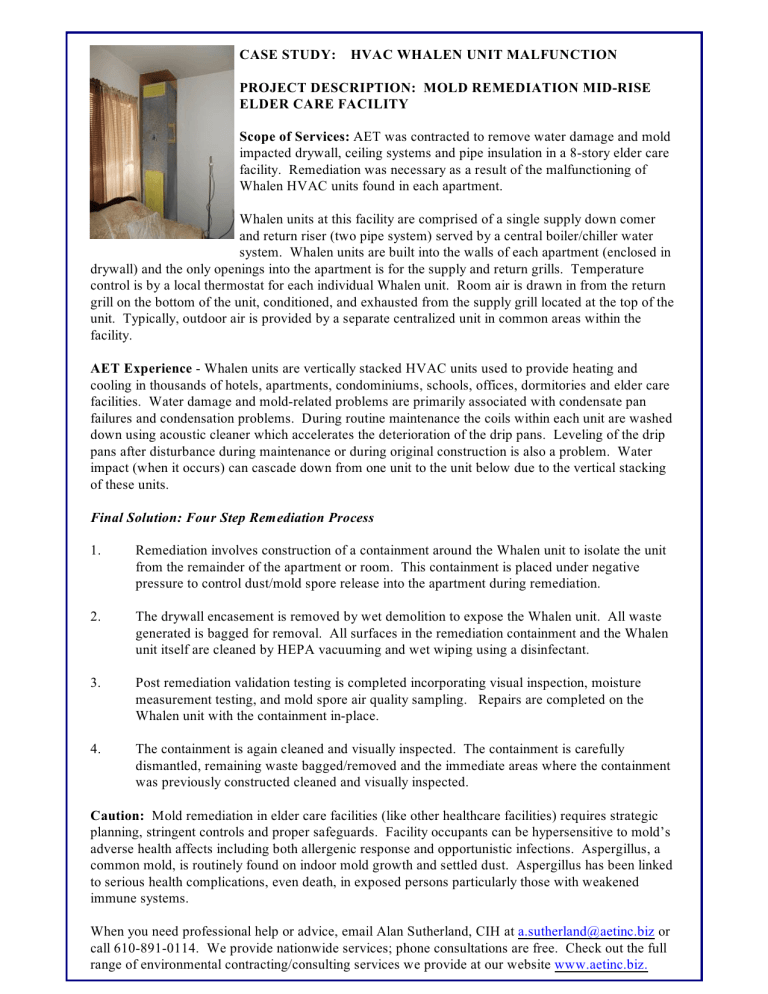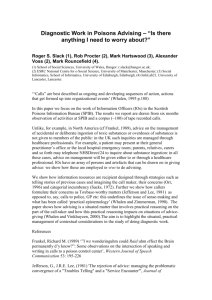CASE STUDY: HVAC WHALEN UNIT MALFUNCTION PROJECT

CASE STUDY: HVAC WHALEN UNIT MALFUNCTION
PROJECT DESCRIPTION: MOLD REMEDIATION MID-RISE
ELDER CARE FACILITY
Scope of Services: AET was contracted to remove water damage and mold impacted drywall, ceiling systems and pipe insulation in a 8-story elder care facility. Remediation was necessary as a result of the malfunctioning of
Whalen HVAC units found in each apartment.
Whalen units at this facility are comprised of a single supply down comer and return riser (two pipe system) served by a central boiler/chiller water system. Whalen units are built into the walls of each apartment (enclosed in drywall) and the only openings into the apartment is for the supply and return grills. Temperature control is by a local thermostat for each individual Whalen unit. Room air is drawn in from the return grill on the bottom of the unit, conditioned, and exhausted from the supply grill located at the top of the unit. Typically, outdoor air is provided by a separate centralized unit in common areas within the facility.
AET Experience - Whalen units are vertically stacked HVAC units used to provide heating and cooling in thousands of hotels, apartments, condominiums, schools, offices, dormitories and elder care facilities. Water damage and mold-related problems are primarily associated with condensate pan failures and condensation problems. During routine maintenance the coils within each unit are washed down using acoustic cleaner which accelerates the deterioration of the drip pans. Leveling of the drip pans after disturbance during maintenance or during original construction is also a problem. Water impact (when it occurs) can cascade down from one unit to the unit below due to the vertical stacking of these units.
Final Solution: Four Step Remediation Process
1.
Remediation involves construction of a containment around the Whalen unit to isolate the unit from the remainder of the apartment or room. This containment is placed under negative pressure to control dust/mold spore release into the apartment during remediation.
2.
3.
The drywall encasement is removed by wet demolition to expose the Whalen unit. All waste generated is bagged for removal. All surfaces in the remediation containment and the Whalen unit itself are cleaned by HEPA vacuuming and wet wiping using a disinfectant.
Post remediation validation testing is completed incorporating visual inspection, moisture measurement testing, and mold spore air quality sampling. Repairs are completed on the
Whalen unit with the containment in-place.
4.
The containment is again cleaned and visually inspected. The containment is carefully dismantled, remaining waste bagged/removed and the immediate areas where the containment was previously constructed cleaned and visually inspected.
Caution: Mold remediation in elder care facilities (like other healthcare facilities) requires strategic planning, stringent controls and proper safeguards. Facility occupants can be hypersensitive to mold’s adverse health affects including both allergenic response and opportunistic infections. Aspergillus, a common mold, is routinely found on indoor mold growth and settled dust. Aspergillus has been linked to serious health complications, even death, in exposed persons particularly those with weakened immune systems.
When you need professional help or advice, email Alan Sutherland, CIH at a.sutherland@aetinc.biz
or call 610-891-0114. We provide nationwide services; phone consultations are free. Check out the full range of environmental contracting/consulting services we provide at our website www.aetinc.biz.

